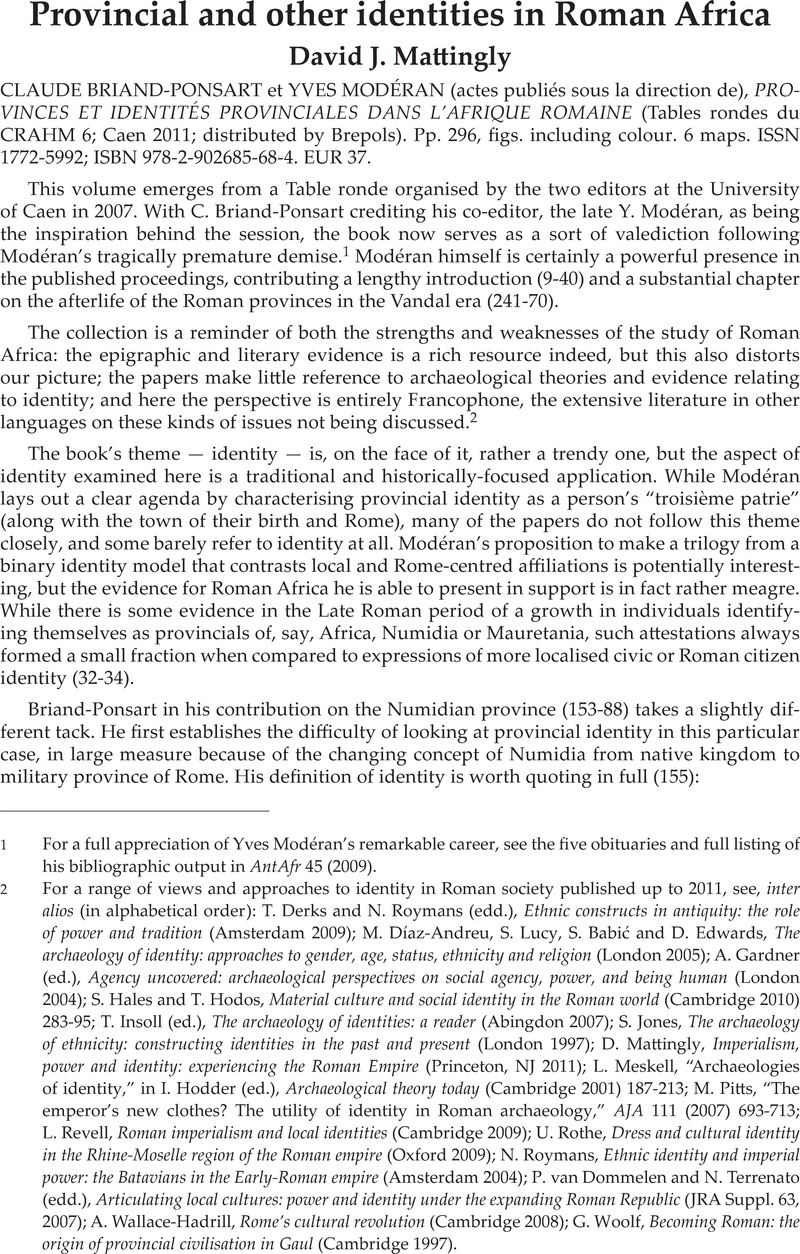No CrossRef data available.
Published online by Cambridge University Press: 27 November 2014

1 For a full appreciation of Yves Modéran’s remarkable career, see the five obituaries and full listing of his bibliographic output in AntAfr 45 (2009)Google Scholar.
2 For a range of views and approaches to identity in Roman society published up to 2011, see, inter alios (in alphabetical order): Derks, T. and Roymans, N. (edd.), Ethnic constructs in antiquity: the role of power and tradition (Amsterdam 2009)CrossRefGoogle Scholar; Díaz-Andreu, M., Lucy, S., Babić, S. and Edwards, D., The archaeology of identity: approaches to gender, age, status, ethnicity and religion (London 2005)Google Scholar; Gardner, A. (ed.), Agency uncovered: archaeological perspectives on social agency, power, and being human (London 2004)Google Scholar; Hales, S. and Hodos, T., Material culture and social identity in the Roman world (Cambridge 2010) 283–95Google Scholar; Insoll, T. (ed.), The archaeology of identities: a reader (Abingdon 2007)CrossRefGoogle Scholar; Jones, S., The archaeology of ethnicity: constructing identities in the past and present (London 1997)Google Scholar; Mattingly, D., Imperialism, power and identity: experiencing the Roman Empire (Princeton, NJ 2011)Google Scholar; Meskell, L., “Archaeologies of identity,” in Hodder, I. (ed.), Archaeological theory today (Cambridge 2001) 187–213 Google Scholar; Pitts, M., “The emperor’s new clothes? The utility of identity in Roman archaeology,” AJA 111 (2007) 693–713 CrossRefGoogle Scholar; Revell, L., Roman imperialism and local identities (Cambridge 2009)Google Scholar; Rothe, U., Dress and cultural identity in the Rhine-Moselle region of the Roman empire (Oxford 2009)CrossRefGoogle Scholar; Roymans, N., Ethnic identity and imperial power: the Batavians in the Early-Roman empire (Amsterdam 2004)CrossRefGoogle Scholar; van Dommelen, P. and Terrenato, N. (edd.), Articulating local cultures: power and identity under the expanding Roman Republic (JRA Suppl. 63, 2007)Google Scholar; Wallace-Hadrill, A., Rome’s cultural revolution (Cambridge 2008)Google Scholar; Woolf, G., Becoming Roman: the origin of provincial civilisation in Gaul (Cambridge 1997)Google Scholar.
3 Sen, A., Identity and violence: the illusion of destiny (New York 2006)Google Scholar. In a N African context, see now Conant, J., Staying Roman: conquest and identity in Africa and the Mediterranean, 439-700 (Cambridge 2012)CrossRefGoogle Scholar, and Rebillard, E., Christians and their many identities in late antiquity: North Africa 200-450 CE (Ithaca, NY 2012)CrossRefGoogle Scholar, both reviewed in this issue.
4 See now Stark, B. L. and Chance, J. K., “The strategies of provincials in empires,” in Smith, M. E. (ed.), The comparative archaeology of complex societies (Cambridge 2012) 192–237 Google Scholar; cf. Gardner, A., “Thinking about Roman imperialism: postcolonialism, globalization and beyond?,” Britannia 44 (2013) 1–25 Google Scholar; Mattingly, D., “Identities in the Roman world: discrepancy, heterogeneity, hybridity and plurality,” in Brody, L. and Hoffman, G. L., Roman in the provinces: art on the periphery of empire (Boston, MA 2014) 32–61 Google Scholar.
5 Hitchner, R. B., “Globalization avant la lettre: globalization and the history of the Roman empire,” New Global Studies 2.2 (2008), doi: 10.2202/1940-0004.1034CrossRefGoogle Scholar; T. Hodos, “Local and global perspectives in the study of social and cultural identities,” in Hodos and Hales (supra n.1) 23-27; Pitts, M., “Globalizing the local in Roman Britain: an anthropological approach to social change,” JAnthArch 27 (2008) 493–506 Google Scholar; Witcher, R., “Globalisation and Roman imperialism: perspectives on identities in Roman Italy,” in Herring, E. and Lomas, K. (edd.), The emergence of state identities in Italy in the first millennium BC (London 2000) 213–25Google Scholar.
6 Mattingly, D. “Being Roman: expressing identity in a provincial setting,” JRA 17 (2004) 5–25 Google Scholar.
7 Brody, L. and Hoffman, G. L. (edd.), Dura Europos: crossroads of antiquity (Boston, MA 2011)Google Scholar; eaedem (supra n.4).
8 Cf. 69: “nous devons remarquer maintenant que de tous ces peuples, nous ne connaissons que le nom. L’archéologie n’est pas, ou pas encore, en mesure de donner des informations”.
9 Younès, H. Ben, “Interculturality and the Punic funerary world,” in Stone, D. and Stirling, L. (edd.), Mortuary landscapes of North Africa (Toronto 2007) 32–42 CrossRefGoogle Scholar; Ghaki, M., Les haouanet de Sidi Mhamed Latrech (Tunis 1999)Google Scholar; D. Stone, “Monuments on the margins: interpreting the protohistoric rock-cut tombs (Haouanet) of North Africa,” in id. and Stirling ibid. 43-74; id., “Burial, identity, and local culture in North Africa,” in van Dommelen and Terrenato (supra n.1) 126-44.
10 See most recently Mattingly, D., The archaeology of Fazzān vol. 4: survey and excavations at Old Jarma (ancient Garama) carried out by C. M. Daniels (1962-69) and the Fazzān Project (1997-2001) (London 2013) especially 505–44Google Scholar; id. and M. Sterry, “The first towns in the central Sahara,” Antiquity 85 [336] (2013) 503-18.
11 Courtois, C., Les Vandales et l’Afrique (Paris 1955) 65–91 Google Scholar.
12 Trousset, P., Recherches sur le ‘limes Tripolitanus’ du Chott el-Djerid à la frontière tuniso-libyenne (Paris 1974)CrossRefGoogle Scholar; Mattingly, D., Tripolitania (London 1995)Google Scholar.
13 See Mattingly (supra n.2) 236-45 for some initial ideas.